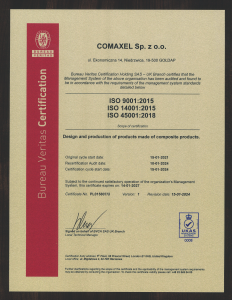
Comaxel is certified with all three main standards.
ISO 9001:2015, ISO 14001:2015 and ISO 45001:2018.
What is ISO 9001?
ISO 9001 is a globally recognized standard for quality management. It helps organizations of all sizes and sectors to improve their performance, meet customer expectations and demonstrate their commitment to quality. Its requirements define how to establish, implement, maintain, and continually improve a quality management system (QMS).
Implementing ISO 9001 means your organization has put in place effective processes and trained staff to deliver flawless products or services time after time.
Why is ISO 9001 important?
With more than one million certificates issued to organizations in 189 countries, ISO 9001 is the most widely used quality management standard in the world. Within the ISO 9000 family, which defines seven quality management principles including a strong customer focus and continual improvement, ISO 9001 is the only standard that can be certified to (though certification is not mandatory).
Business benefits include:
- Customer confidence: The standard ensures that organizations have robust quality control processes in place, leading to increased customer trust and satisfaction.
- Effective complaint resolution: ISO 9001 offers guidelines for resolving customer complaints efficiently, contributing to timely and satisfactory problem-solving.
- Process improvement: The standard helps identify and eliminate inefficiencies, reduce waste, streamline operations, and promote informed decision-making, resulting in cost savings and better outcomes.
- Ongoing optimization: Regular audits and reviews encouraged by ISO 9001 enable organizations to continually refine their quality management systems, stay competitive, and achieve long-term success.
What is ISO 14001?
ISO 14001 is the internationally recognized standard for environmental management systems (EMS). It provides a framework for organizations to design and implement an EMS, and continually improve their environmental performance. By adhering to this standard, organizations can ensure they are taking proactive measures to minimize their environmental footprint, comply with relevant legal requirements, and achieve their environmental objectives. The framework encompasses various aspects, from resource usage and waste management to monitoring environmental performance and involving stakeholders in environmental commitments.
Why is ISO 14001 important?
In an age of heightened environmental consciousness and increasing global challenges such as climate change, biodiversity loss, and resource depletion, organizations have a pivotal role to play. ISO 14001 offers a structured approach for businesses to address these pressing concerns. By adopting this standard, organizations signal a commitment not only to regulatory compliance but also to ongoing environmental improvement. This proactive approach to environmental management can result in tangible benefits, such as reduced waste, energy conservation, and cost savings.
Furthermore, it enhances an organization’s reputation, fosters stakeholder trust, and often constitutes a critical step for engaging in global trade and supply chains. Simply put, ISO 14001 stands as a testament to an organization’s dedication to a sustainable future, blending environmental responsibility with strategic business growth.
What is ISO 45001?
ISO 45001 is an international standard that specifies requirements for an occupational health and safety (OH&S) management system. It provides a framework for organizations to manage risks and improve OH&S performance.
The standard establishes criteria for an OH&S policy, objectives, planning, implementation, operation, auditing and review. Key elements include leadership commitment, worker participation, hazard identification and risk assessment, legal and regulatory compliance, emergency planning, incident investigation and continual improvement.
ISO 45001 utilizes the Plan-Do-Check-Act methodology to systematically manage health and safety risks. It applies to organizations of all sizes and can be integrated with other ISO management system standards.
Why is ISO 45001 important?
Implementing ISO 45001 provides significant value to organizations looking to reduce workplace incidents and demonstrate OH&S commitment. Benefits include:
- ISO 45001 provides an internationally-recognized framework for managing occupational health and safety risks. It enables organizations to systematically assess hazards and implement risk control measures, leading to reduced workplace injuries, illnesses and incidents.
- Adopting the standard shows employees and external stakeholders that the organization is committed to worker health, safety and wellbeing. This boosts reputation, morale and retention.
- The standard requires complying with OH&S regulations, ensuring legal conformity. It also promotes proactive risk management, potentially lowering insurance premiums.
- By requiring emergency preparedness and response protocols, ISO 45001 strengthens organizational resilience against safety threats and crises.
- The framework of plan, do, check act means the OH&S system can continually improve and evolve, enhancing long-term worker health and safety performance.
In summary, ISO 45001 enables organizations to better protect their workers and manage OH&S risks, making it an essential standard worldwide.
